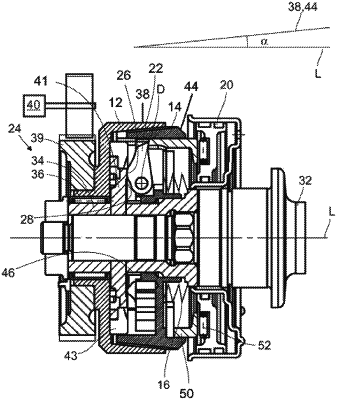| CPC F16D 13/30 (2013.01) [F16D 13/66 (2013.01); F16D 23/12 (2013.01); F16D 25/082 (2013.01); F16D 2023/126 (2013.01)] | 9 Claims |

|
1. A coupling arrangement (24) comprising:
a first component (12), which defines a longitudinal axis (L);
a second component (14), which is displaceably mounted along the longitudinal axis (L);
a press-on element (16), which pretensions the second component (14) in a first position, in which the second component (14) is in frictional engagement with the first component (12); and
an actuating unit (18), with which the second component (14) can be displaced from the first position to a second position, in which the second component (14) is distanced from the first component (12), wherein the actuating unit (18)
an actuator (20), which is displaceable along the longitudinal axis (L) and thereby provides an opening force; and
a lever (22) which is rotatably mounted in the second component (14) about an axis of rotation (D) that is perpendicular to the longitudinal axis (L), and has a contact surface (26), with which the lever (22) is in contact with a fixed mating surface (28), wherein the contact surface (26) and/or the mating surface (28) has a convex curvature (30),
wherein the actuator (20) and the lever (22) cooperate in such a way that the movement of the actuator (20) along the longitudinal axis (L) is converted into a movement of the lever (22) on the mating surface (28), whereby the second component (14) is displaced along the longitudinal axis (L) in the second position, and
wherein the lever (22) is a two-sided lever.
|